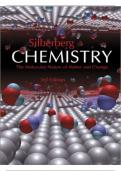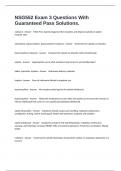,Solution Manual For
Chemistry The Molecular Nature of Matter and Change 3CE Martin Silberberg, Patricia Amateis,
Rashmi Venkateswaran, Lydia Chen
Chapter 1-25
CHAPTER 1 KEYS TO THE STUDY OF CHEMISTRY
END–OF–CHAPTER PROBLEMS
1.1 Plan: If only the form of the particles has changed and not the composition of the particles, a physical change has
taken place; if particles of a different composition result, a chemical change has taken place.
Solution:
a) The result in C represents a chemical change as the substances in A (red spheres) and B (blue spheres) have
reacted to become a different substance (particles consisting of one red and one blue sphere) represented in C.
There are molecules in C composed of the atoms from A and B.
b) The result in D represents a chemical change as again the atoms in A and B have reacted to form molecules of
a new substance.
c) The change from C to D is a physical change. The substance is the same in both C and D (molecules
consisting of one red sphere and one blue sphere) but is in the gas phase in C and in the liquid phase in D.
d) The sample has the same chemical properties in both C and D since it is the same substance but has different
physical properties.
1.2 Plan: Apply the definitions of the states of matter to a container. Next, apply these definitions to the examples.
Gas molecules fill the entire container; the volume of a gas is the volume of the container. Solids and liquids have
a definite volume. The volume of the container does not affect the volume of a solid or liquid.
Solution:
a) The helium fills the volume of the entire balloon. The addition or removal of helium will change the volume of
a balloon. Helium is a gas.
b) At room temperature, the mercury does not completely fill the thermometer. The surface of the liquid mercury
indicates the temperature.
c) The soup completely fills the bottom of the bowl, and it has a definite surface. The soup is a liquid, though it is
possible that solid particles of food will be present.
1.3 Plan: Apply the definitions of the states of matter to a container. Next, apply these definitions to the examples.
Gas molecules fill the entire container; the volume of a gas is the volume of the container. Solids and liquids have
a definite volume. The volume of the container does not affect the volume of a solid or liquid.
Solution:
a) The air fills the volume of the room. Air is a gas.
b) The vitamin tablets do not necessarily fill the entire bottle. The volume of the tablets is determined by the
number of tablets in the bottle, not by the volume of the bottle. The tablets are solid.
c) The sugar has a definite volume determined by the amount of sugar, not by the volume of the container. The
sugar is a solid.
1.4 Plan: Define the terms and apply these definitions to the examples.
Solution:
Physical property – A characteristic shown by a substance itself, without interacting with or changing into other
substances.
Chemical property – A characteristic of a substance that appears as it interacts with, or transforms into, other
substances.
a) The change in color (yellow–green and silvery to white), and the change in physical state (gas and metal to
crystals) are examples of physical properties. The change in the physical properties indicates that a chemical
change occurred. Thus, the interaction between chlorine gas and sodium metal producing sodium chloride is an
example of a chemical property.
Silberberg, Amateis, Venkateswaran, Chen, Chemistry: The Molecular Nature of Matter and Change, 3rd Canadian Edition Page 1-1
Instructor‘s Solution Manual © Copyright 2021 McGraw-Hill Ryerson Ltd.
, b) The sand and the iron are still present. Neither sand nor iron became something else. Colors along with
magnetism are physical properties. No chemical changes took place, so there are no chemical properties to
observe.
1.5 Plan: Define the terms and apply these definitions to the examples.
Solution:
Physical change – A change in which the physical form (or state) of a substance, but not its composition, is
altered.
Chemical change – A change in which a substance is converted into a different substance with different
composition and properties.
a) The changes in the physical form are physical changes. The physical changes indicate that there is also a
chemical change. Magnesium chloride has been converted to magnesium and chlorine.
b) The changes in color and form are physical changes. The physical changes indicate that there is also a
chemical change. Iron has been converted to a different substance, rust.
1.6 Plan: Apply the definitions of chemical and physical changes to the examples.
Solution:
a) Not a chemical change, but a physical change — simply cooling returns the soup to its original form.
b) There is a chemical change — cooling the toast will not ―un–toast‖ the bread.
c) Even though the wood is now in smaller pieces, it is still wood. There has been no change in composition, thus
this is a physical change, and not a chemical change.
d) This is a chemical change converting the wood (and air) into different substances with different compositions.
The wood cannot be ―unburned.‖
1.7 Plan: If there is a physical change, in which the composition of the substance has not been altered, the process
can be reversed by a change in temperature. If there is a chemical change, in which the composition of the
substance has been altered, the process cannot be reversed by changing the temperature.
Solution:
a) and c) can be reversed with temperature; the dew can evaporate and the ice cream can be refrozen.
b) and d) involve chemical changes and cannot be reversed by changing the temperature since a chemical change
has taken place.
1.8 Plan: A system has a higher potential energy before the energy is released (used).
Solution:
a) The exhaust is lower in energy than the fuel by an amount of energy equal to that released as the fuel burns.
The fuel has a higher potential energy.
b) Wood, like the fuel, is higher in energy by the amount released as the wood burns.
1.9 Plan: Kinetic energy is energy due to the motion of an object.
Solution:
a) The sled sliding down the hill has higher kinetic energy than the unmoving sled.
b) The water falling over the dam (moving) has more kinetic energy than the water held by the dam.
1.10 Alchemical: chemical methods – distillation, extraction; chemical apparatus
Medical: mineral drugs
Technological: metallurgy, pottery, glass
1.11 Combustion released the otherwise undetectable phlogiston. The more phlogiston a substance contained; the
more easily it burned. Once all the phlogiston was gone, the substance was no longer combustible.
1.12 The mass of the reactants and products are easily observable quantities. The explanation of combustion must
include an explanation of all observable quantities. Their explanation of the mass gain required phlogiston to
have a negative mass.
Silberberg, Amateis, Venkateswaran, Chen, Chemistry: The Molecular Nature of Matter and Change, 3rd Canadian Edition Page 1-2
Instructor‘s Solution Manual © Copyright 2021 McGraw-Hill Ryerson Ltd.
, 1.13 Lavoisier measured the total mass of the reactants and products, not just the mass of the solids. The total mass of
the reactants and products remained constant. His measurements showed that a gas was involved in the reaction.
He called this gas oxygen (one of his key discoveries).
1.14 Observations are the first step in the scientific approach. The first observation is that the toast has not popped out
of the toaster. The next step is a hypothesis (tentative explanation) to explain the observation. The hypothesis is
that the spring mechanism is stuck. Next, there will be a test of the hypothesis. In this case, the test is an
additional observation — the bread is unchanged. This observation leads to a new hypothesis — the toaster is
unplugged. This hypothesis leads to additional tests — seeing if the toaster is plugged in, and if it works when
plugged into a different outlet. The final test on the toaster leads to a new hypothesis — there is a problem with the
power in the kitchen. This hypothesis leads to the final test concerning the light in the kitchen.
1.15 A quantitative observation is easier to characterize and reproduce. A qualitative observation may be subjective
and open to interpretation.
a) This is qualitative. When has the sun completely risen?
b) The astronaut‘s mass may be measured; thus, this is quantitative.
c) This is qualitative. Measuring the fraction of the ice above or below the surface would make this a
quantitative measurement.
d) The depth is known (measured) so this is quantitative.
1.16 A well-designed experiment must have the following essential features:
1) There must be two variables that are expected to be related.
2) There must be a way to control all the variables, so that only one at a time may be changed.
3) The results must be reproducible.
1.17 A model begins as a simplified version of the observed phenomena, designed to account for the observed effects,
explain how they take place, and to make predictions of experiments yet to be done. The model is improved by
further experiments. It should be flexible enough to allow for modifications as additional experimental results are
gathered.
1.18 The unit you begin with (kilometres) must be in the denominator to cancel. The unit desired (centimetres) must
be in the numerator. The kilometres will cancel leaving centimetres. If the conversion is inverted the answer
would be in units of kilometres squared per centimetre.
1.19 Plan: Review the table of conversions in the chapter or inside the back cover of the book. Write the conversion
factor so that the unit initially given will cancel, leaving the desired unit.
Solution:
a) To convert from cm2 to m2, use
1 m 2
100 cm 2
b) To convert from km2 to m2, use
1000 m 2 ; to convert from m2 to cm2, use 100 cm 2
1 km 2 1 m 2
c) This problem requires two conversion factors: one for distance (km to m) and one for time (h to s). It does not
matter which conversion is done first and alternate methods may be used.
To convert distance, km to m, use:
1000 m 3
= 10 m/km
1 km
To convert time, h to s, use:
1 h 1 min 1h
60 min 60 s 3600 s
Therefore, the complete conversion factor is:
1000 m 1 h 1 mh
km 3600 s 3.6 km s
Silberberg, Amateis, Venkateswaran, Chen, Chemistry: The Molecular Nature of Matter and Change, 3rd Canadian Edition Page 1-3
Instructor‘s Solution Manual © Copyright 2021 McGraw-Hill Ryerson Ltd.





